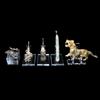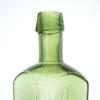Palmer Museum Highlights 19th-Century American Still-Lifes in Fall Exhibition
- UNIVERSITY PARK, Pennsylvania
- /
- August 21, 2018
The Palmer Museum of Art at Penn State has announced the opening of the fall exhibition, "Object Lessons: American Still-Life Painting in the Nineteenth Century."
"Object Lessons: American Still-Life Painting in the Nineteenth Century" opens Sept. 4 in the first-floor special exhibitions gallery. The show highlights the rich tradition of still-life painting in the United States with an emphasis on Pennsylvania’s influential role in that history. The 22 works featured in "Object Lessons" explore a variety of themes – from the brevity of life, to the bounty of the continent, to the poetic power and meaning of the commonplace. Rarely seen loans from private collectors complement the holdings of the Palmer to explore how flowers, fruit and simple household items have transfixed and beguiled viewers from the nineteenth century to the present day.
“The Palmer is committed to presenting exhibitions that explore different periods and styles in American art,” said Erin Coe, director of the Palmer Museum of Art. “This exhibition places masterworks from the collection in dialogue with loans from private hands to better understand the development and cultural significance of still-life painting in the 19th century, when the genre was at its height of popularity.”
Pennsylvania artists were at the forefront of the still-life genre, and the exhibition features works by a number of painters local to or identified with the Commonwealth, notably William Michael Harnett, Albert F. King, Rubens Peale, John Frederick Peto and Severin Roesen. "Object Lessons" also includes a varied roster of important artists who gravitated toward depicting inanimate objects amid the rising commodity culture and cosmopolitan networks of the Gilded Age, among them William Mason Brown, William Merritt Chase, Charles Caryl Coleman, Martin Johnson Heade and Elihu Vedder.
“The exhibition not only brings together a distinguished group of artists who excelled at still-life painting, but it is also an opportunity to consider premier, though seldom exhibited, examples by them,” said Adam Thomas, curator of American art at the Palmer.
Support for "Object Lessons" was provided by Art Bridges, a non-profit started in 2017 by Alice Walton to share outstanding works of American art with those that have limited access to the country’s most meaningful works. Art Bridges partners with art institutions of all sizes on projects that deeply engage their surrounding communities. The exhibition will run through Dec. 16.
"Instinctive Gestures: Recent Gifts from the Fishman-MacElderry Collection" opens on Aug. 28, anintimate, yet bright and exuberant exhibition spotlights 13 works from the important gift of paintings, works on paper, and prints by contemporary artists donated to the Palmer in 2016 by Marilyn Fishman and James MacElderry.
"Instinctive Gestures" runs through Dec. 16.
A major retrospective of the career of Pennsylvania artist G. Daniel Massad opens at the Palmer in late September.
About the Palmer
The Palmer Museum of Art on the Penn State University Park campus is a free-admission arts resource for the University and surrounding communities in central Pennsylvania. With a collection of 9,000 objects representing and spanning a variety of cultures and centuries of art, the Palmer is the largest art museum between Pittsburgh and Philadelphia. Areas of strength include the museum’s collection of American art from the late 18th century to the present; Old Master paintings; prints and photography; ceramics and studio glass; and a growing collection of modern and contemporary art. The museum presents ten exhibitions each year and, with eleven galleries, a print-study room, a 150-seat auditorium, and an outdoor sculpture garden, is the leading cultural resource for the region.
Museum hours are 10 a.m. to 4:30 p.m. Tuesdays through Saturdays; noon to 4 p.m. Sundays; and 6 to 9 p.m. on the third Thursday of each month. The museum is closed Mondays and some holidays.
The Palmer receives state arts funding support through a grant from the Pennsylvania Council on the Arts, a state agency funded by the Commonwealth of Pennsylvania.
For more information on the Palmer Museum of Art or for the calendar of upcoming events, visit palmermuseum.psu.edu.















31100x100_c.jpg)